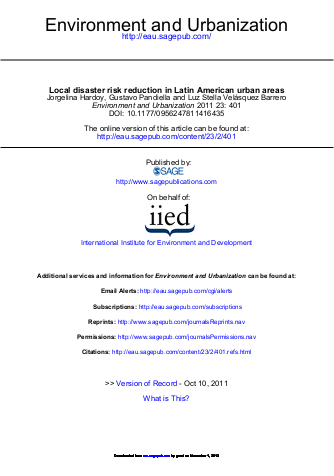
It is widely acknowledged that disaster risk reduction is a development issue best addressed locally with community involvement, as an integral part of local development. Yet there are many constraints and realities that complicate the attainment of this ideal. This paper reviews the experience in disaster risk reduction in a range of cities, including Manizales, Colombia, which has integrated risk reduction into its development plan and its urban environmental management. The city government has also established an insurance programme for buildings that provides coverage for low-income households. The paper further describes and discusses the experiences of other city governments, including those of Santa Fe in Argentina and Medellín in Colombia. It emphasizes how, in order to be effective, disaster risk reduction has to be driven locally and must include the involvement of communities at risk as well as local governments. It also has to be integrated into development and land use management. But the paper emphasizes how these key local processes need support from higher levels of government and, very often, inter-municipal cooperation. Political or administrative boundaries seldom coincide with the areas where risk reduction needs to be planned and implemented. The paper also includes some discussion of innovations in national systems and funds to support local disaster risk reduction.
Resource collections
- UN Habitat - Urban Response Collection
- Urban Response - Urban Crisis Preparedness and Risk Reduction
- Urban Response Collection - Community Engagement and Social Cohesion
- Urban Response Collection - Economic Recovery
- Urban Response Collection - Environment and Climate Change
- Urban Response Collection - Housing, Land and Property
- Urban Response Collection - Urban Crisis Response, Recovery and Reconstruction
- Urban Response Collection - Urban Resilience